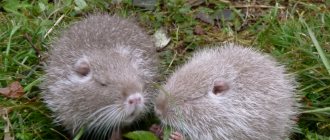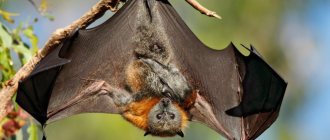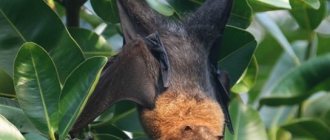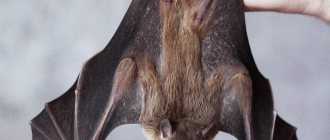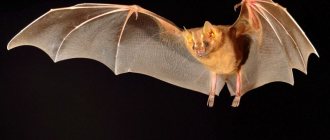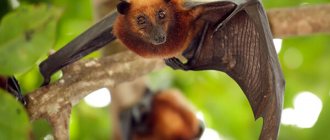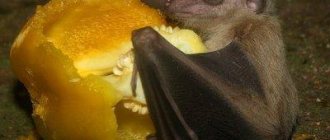- Wild animals
- >>
- Mammals
The flying dog is a very mysterious mammal, an encounter with which, especially at night, leaves no one indifferent. His life is covered in many myths and legends. Fruit bats are associated with the outside world; in many cultures they have a dark, bad reputation. Quite often they are confused with bats.
Who are they, these unusual animals?
Even the mention of bats evokes negative emotions in many people. For many years they were considered vampires, assistants of the devil, or simply vile animals. These little animals are unlikely to cause strong disgust. Moreover, many admirers believe that the flying dog can be an excellent pet.
The muzzles of fruit bats are very similar to those of a dog or fox. The structure of their skull is in some way similar to the structure of the skull of lower primates. The largest individuals have a wingspan of 150-170 cm. They use them as a blanket in cold weather, and in hot weather they use them as a fan. The sizes of different species differ significantly, the length ranges from 5 to 40 centimeters. The weight, accordingly, varies from 15 to 900 grams. The flying dog has teeth that are adapted only to plant foods. The tongue of the fruit bat is covered with papillae, and in small representatives of this species it is also very long. Fruit bats have a well-developed sense of smell and vision. The color of the flying dog is usually dark brown, but there are individuals with a greenish, yellowish tint or with white spots on the wings. Males have a brighter color, while females are smaller in size and much more modest in color.
Hammerhead fruit bat
If, in the humid forests of equatorial Africa, a bug-eyed, donkey-like head with wings suddenly catches your eye, then this is a hammerhead fruit bat,
a lover of night serenades and the owner of the most unusual appearance in his family.
During the mating season, gentlemen gather creative groups of several dozen performers and throw a concert, calling for females. They buzz and croak, whoever is louder. And the one with the bigger nose is louder. And not just the nose.
It is difficult to find mammals in which the male and female organisms were as different. In other species of fruit bats, you can’t tell who is who in a colony hanging upside down, and a pair of these animals resembles a duet of a flutist and an organist traveling with their instruments. Not by sounds, but by dimensions.
The hammerhead male carries an entire acoustic installation within himself. The nose is curved to increase the internal volume of the nasal sinuses; massive leathery folds dotted with protrusions and warts descend to the bifurcated lower lip on both sides. A sort of rosette around the mouth and nostrils.
The vocal apparatus and trachea are of such a size that the heart, lungs and other organs had to make room, giving way to half the entire length of the fruit bat’s spine. In addition, the system is equipped with two throat air bags to enhance the effect. As a result, the sound comes out like from a barrel, carries far and loudly.
This could not but affect the difference in size between male and female individuals - females have the traditional appearance and grace of fruit bats, while the male is almost twice as large and heavy. Accordingly, the wingspan is larger - almost a meter.
Even in their choice of food, male hammerhead fruit bats behave like pampered stars of the stage - give them bananas, guava, mangoes of the highest quality, and they are ready to fly more than 10 kilometers for them. And during the fig ripening season, they flock to trees in numbers no less than during the mating season.
On the one hand, local planters do not like this very much, but on the other hand, they are very happy, because local residents consider the meat of these bats to be tasty and healthy. Maybe so, or maybe it’s just veiled revenge for spitting out fruits in their plantings. The “singers” do not eat the fruits themselves, but only chew the juice out of them dry.
The hammerhead fruit bat is the largest in its family, and the processing of fruits into energy for songs and flights requires a lot of raw materials.
Fortunately, they do not form large colonies, and therefore they are not classified as pest species.
Our Zen Channel
Features of the view
The flying dog has one interesting feature - it does not have a tail. Some other species have it, but it is very small. And only one representative of fruit bats has a luxurious tail, for which it was called the long-tailed fruit bat. Flying foxes also have rather unusual paws: a tenacious and long claw and the last phalanx are present only on the first and much less often on the second toe. The interfemoral membrane is underdeveloped in many species. The flying dog's intestines are 4 times longer than its body.
Animals have a well-developed sense of smell, but only some of them use echolocation (in particular, the genus Rosethus) in order to navigate in space. The sounds that fruit bats make are also very original. Rosethuses, for example, make a ticking sound during takeoff and landing.
Nutrition
They especially love to eat bananas, papaya, coconuts, grapes, and avocados. Pygmy flying foxes also feed on flower nectar. These “dogs” in a whole flock sit on a tree and begin to eat its ripened fruits. But they don’t eat them, they simply suck out the juice with a small amount of pulp. The rest is spat out. In search of food, animals fly up to 40 km per night. Favorite food is figs, then oranges, dates, bananas and young carob leaves.
- 72 facts about plants
- Animals of Siberia
- 35 facts about giraffes
- Animals of Crimea
- 36 facts about elephants
- Rodents
Types of flying dogs
Fruit bats are divided into many species. For example, the Egyptian flying dog. Despite its name, this species is distributed not only in Egypt, but also throughout almost the entire African continent, as well as in Pakistan, the Middle East, and the northern part of India. Due to its cute appearance, this species is preferred by some people to keep as pets. This is due to the fact that they do not have an unpleasant odor and are easy to train. In addition to the Egyptian fruit bat, there is also the Comorian, bare-backed, prehensile-tailed, Madagascar, and Ugandan flying dogs.
Lifestyle and habitat
Many species of night fruit bats are easily tamed by humans. These primarily include Egyptian representatives of this genus of fauna (in addition to what was mentioned earlier, another name is often applied to such creatures - Nile fruit bats). These creatures are distinguished by their complacent character and natural intelligence, and they are also capable of becoming very attached to their owner.
Domestic flying dogs are usually kept in a spacious enclosure by lovers of exotic creatures. In addition, they can be placed in a living room in a fenced part of it. Considering the social nature of these pets, it is better to have not one, but several flying dogs at once.
Otherwise, there is a high probability that the lonely creature will begin to indulge in depression. Ordinary straw is suitable as bedding for the floor in your home; you can also use small wood shavings. The diet depends on the species.
Nile fruit bats are usually fed compote, dry vegetables, and fruit porridge. The only pity is that such pets are not very neat. These naughty creatures often scatter stale food and shit anywhere. Their feces have a runny consistency and smell very unpleasant.
Under natural conditions, nocturnal fruit bats prefer to settle in forest groves and caves, as well as in dilapidated old buildings, rocky crevices, mines, and cemeteries. The flying dog is an animal that can be found in lowlands and mountainous areas.
Such creatures prefer to live in colonies. They can be very small, amounting to about fifty individuals, or huge, numbering up to two thousand members. Similar settlements of Nile fruit bats can often be found inside centuries-old Egyptian pyramids.
These flying animals are active mainly in the dark. And during the daylight hours they prefer to cling their feet to stones and sleep comfortably upside down. During moments of rest, their pulse rate decreases by almost half. During the day, they may wake up if they feel the presence of uninvited guests in their possessions.
In addition, it is at this time of day that they cleanse themselves, putting their body in order. Among the enemies of these animals are usually birds of prey: falcons, eagle owls and others. They are also bothered by blood-sucking insects and some types of mites.
Offspring
The female gives birth only once a year, giving birth, as a rule, to one baby (very rarely two). Pregnancy lasts approximately 115-120 days on average. During childbirth, the female does not change her traditions and hangs head down, and closes her wings, forming something like a cradle. First, the newborn falls into the wings, and then crawls onto the mother’s chest and clings to the nipple.
Children are born sighted and covered with fur. Until the cub learns to fly, the mother carries it with her. Milk feeding ends approximately when the baby reaches 3 months of age. Grown-up individuals go hunting with their mother. To prevent the cub from getting lost, the female gives him a signal using ultrasound. Fruit bats reach sexual maturity at approximately 9 months.
Price
The most suitable time to buy a continental toy spaniel is from 2.5-3 months. By this period, the dog is usually already weaned from mother's milk and eats adult food. In addition, the initial formation of the appearance has been completed. The puppy is ready to be separated from its first home and go to a new family.
Continental Toy Spaniel Puppy
Before completing a purchase transaction, you should carefully review all documents. Breeders recommend checking the pedigree and also making sure they have vaccinations. It’s good if the dog is mobile, active and cheerful.
But it’s better not to buy lethargic puppies. Most likely they are sick. The average price of a continental toy spaniel varies from 30 to 40 thousand rubles. However, some dogs can cost more. Usually we are talking about show class puppies - the elite of any breed.
Meaning for humans
Some tribes eat flying fox meat. Fruit bats significantly help disperse seeds, and nectarivorous species are able to pollinate plants. Examples of such plants are sausage tree and baobab. However, despite the significant benefits of flying dogs, they often cause damage to garden tree plantations.
Human activity is leading to a gradual decline in the flying dog population. There are fewer and fewer places left for fruit bats to sleep during the day. Many countries are concerned about this situation, and therefore are taking many measures to preserve this species.
Eating behavior
Animals eat plant foods, preferring figs, bananas and citrus fruits. They like sweet fruits, which are high in calories. They often eat flowers, parts of carob and cottonwood trees. They can suck juices from the stems. Typically, Nile fruit bats eat only ripe fruits, and simply suck the juice out of others and then spit them out. Animals do not take food into the cave, with the exception of females who pass food to their cubs.
After eating, flying dogs always clean their fur and elastic membranes by licking. They also clean their teeth with their claws on both their forelimbs and hindlimbs. Such procedures are useful because they relieve fruit bats from fleas and ticks.
Reproduction process
A bat at twelve months of age is considered sexually mature.
In some subspecies, the mating season begins in the spring, while in others they are ready to mate almost all year round. Flying dogs live in small harems of one male and three to five females.
Males are ready to mate all day. The sexual process usually occurs in the dark. With successful fertilization, pregnancy occurs, which lasts up to 110 days.
Delivery occurs in a suspended state. The puppy is born small, blind, but covered with thick hair, which contributes to good thermoregulation. At first, the babies do not leave their mother for a minute and even fly with her to hunt, holding tightly to the female’s fur.
The puppy is born small, blind, but covered with thick hair, which contributes to good thermoregulation
For more than two months, little bats feed exclusively on their mother's milk. After this period, they gradually move away from their parents and join other families.
Under natural conditions, flying dogs live for about 5-7 years; in captivity, this figure doubles.
Italian greyhound character
Greyhound with its owner
By temperamental type, Italian Greyhounds are clearly choleric: excitable, impetuous, hyper-emotional. Bringing an Italian greyhound into your home, you will have to give up the dream of personal space and weekends watching TV or dancing. The overwhelming majority of these smart girls do not agree to put up with the silence and detachment of the owner, since the meaning of life for Italian Greyhounds is continuous contact with a person and a little hunting. Have you already become afraid of such phenomenal obsession? And it’s completely in vain, because small Italian greyhounds are too smart to hang on your hands for hours.
Do not be fooled by the external aristocracy of the breed. Like any hound, the Italian Greyhound loves to play pranks on a grand scale. Chewed Louboutins and a gutted handbag, wallpaper with designer claw stripes and a hair tie worn out to the point of a washcloth - this is not a complete list of the Italian greyhound's daily exploits. In addition, you will have to take into account the fact that psychologically dogs mature slowly. For example, females exhibit puppy-like behavior until they are one year old, while males remain children until they are two years old.
Italian greyhound puppy with cat
Surprisingly, temperament and increased emotionality do not prevent Italian Greyhounds from making friends. In particular, Italian Greyhounds love children very much and willingly make contact with them. They do not see competitors in cats and other dogs with whom they were raised together. But the animal’s loyalty does not extend to small animals like rodents and birds - the hunting habits of the ancestors are triggered.
The favorite places for Italian Greyhounds to be located in an apartment are any horizontal elevations, including chairs, window sills and bedside tables, that is, all those cozy areas that, by definition, are assigned to cats and to which the dog will be able to jump. And she almost always succeeds. These elegant “Italians” will not hesitate to look under the master’s blanket if it suddenly gets cold in the apartment. Separately, it is worth mentioning the “vocality” of the breed. Squealing and barking are as natural for Italian Greyhounds as it is for a person to talk, so don’t even try to restrain such impulses: dogs won’t understand you.
Lifestyle of fruit bats
flying fox
After a hearty meal at dawn, flying foxes return to their roosts, where they will spend the entire day resting their strength after an active night. Winged dogs sleep in flocks in caves or on tree branches. They climb thick branches and hang upside down on their paws and rest in this position. On cool days while sleeping, when flying foxes hang on branches, they wrap their wings around themselves like a blanket, and in hot weather they use them as a fan.
Flying dogs can live in clans on the same tree for tens of years until they are disturbed. These animals prefer a large company of their own kind; settlements of flying foxes often number up to 1 thousand individuals. If necessary, if the area runs out of fruit, fruit bats will fly tens of kilometers, but return to their tree (ceiba, durian and other species). Sometimes during the day you can hear the cries of flying foxes - these are adult males dominating over young ones for the right to have a more comfortable place to rest.
When dusk falls again, the packs of flying dogs will once again set out for their nightly meal. This daily ritual keeps both the fruit bats and their jungle habitat alive. Flying dogs pose a threat only to farmers, because with their numerous colonies they can destroy entire plantations of cultivated crops, thereby causing colossal damage to them.
Flying foxes in captivity
Wild fruit bats can be found in outdoor zoos or botanical gardens. If, when living in freedom, the lifespan of flying dogs rarely reaches 15 years, then in captivity, with proper care, the duration of existence doubles. Cute faces and good disposition have attracted the attention of lovers of exotic pets to flying foxes. To keep a fruit bat at home, you will need a very spacious enclosure.
Relationships with a person
The flying fox easily gets used to communicating with people if it feels a favorable attitude on their part. A fruit bat can allow itself to be stroked by a person who has gained its favor. They happily accept treats from people, such as bananas, apples, avocados and other fruits. A conflict can only arise when fruit bats attack plantations with cultivated crops. At the same time, the winged foxes themselves suffer due to poisoning with pesticides. Flying dogs are of interest to people for their meat, and their fat is used for medicinal purposes.
Virus carriers
In 2005, Eric Leroy of the Franceville International Center for Medical Research discovered in Gabon that Egyptian flying dogs are natural carriers of the Ebola virus. In 2007, Egyptian flying dogs were identified as natural carriers of the Marburg virus. The researchers found that in both cases the animals came from caves in Gabon and the Republic of Congo.
Video
- https://www.zoo-ekzo.ru/node/617https://usatiki.ru/letuchaya-sobaka/https://ru.wikipedia.org/wiki/Flying_dogshttps://ru.wikipedia.org/wiki/ Egyptian_flying_dog https://givotniymir.ru/letuchaya-sobaka-zhivotnoe-obraz-zhizni-i-sreda-obitaniya-letuchej-sobaki/
